WP4
Type of resources
Available actions
Topics
Keywords
Contact for the resource
Provided by
Years
Formats
Representation types
Update frequencies
status
Resolution
-
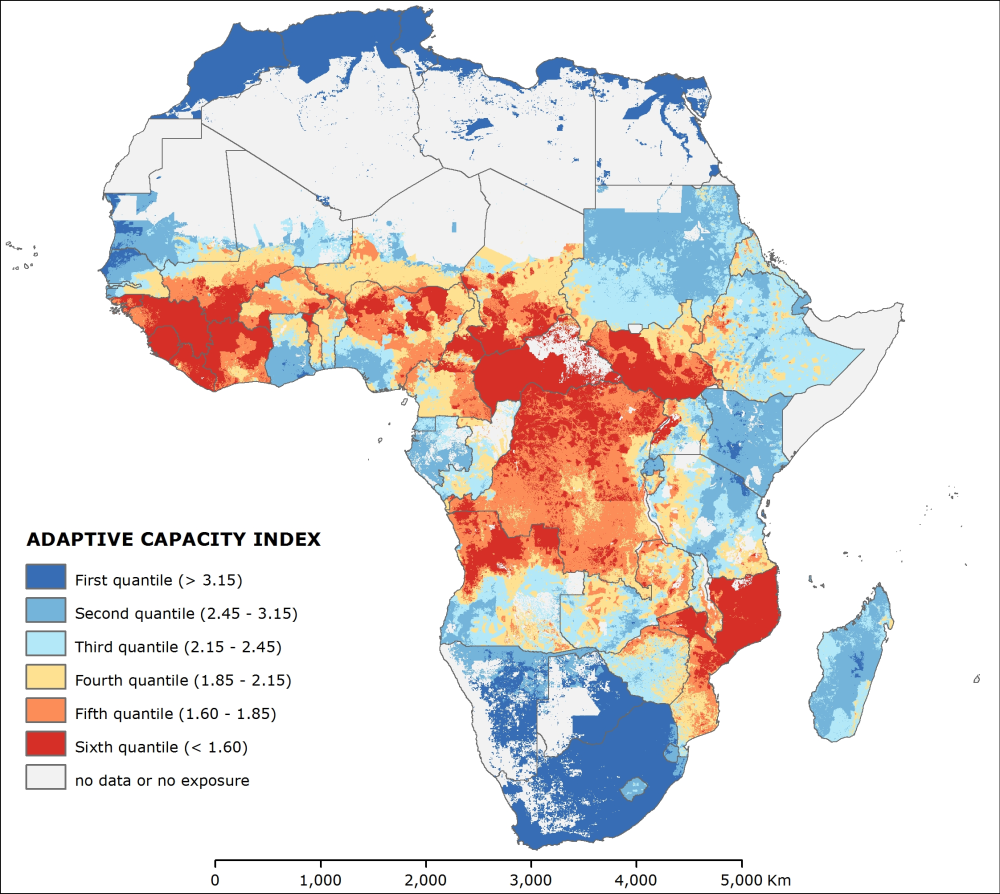
The “adaptive capacity index” symbolizes the adaptive potential to implement adaptation measures that help avert potential impacts in 2010. Adaptive capacity is a significant factor in characterizing vulnerability. The IPCC (2001) describes adaptive capacity as the potential or ability of a system, region, or community to adjust to the effects or impacts of climate change (including climate variability and extremes). Adaptive capacity is considered to be “a function of wealth, technology, education, information, infrastructure, skills, access to resources and stability and management capabilities”. The means of the adaptive capacity are the assets and entitlements that communities and individuals can mobilize in the face of environmental change. The more assets people have, the less vulnerable they are and vice versa. Here adaptive capacity is described as being dependent upon four assets: human capital, technological capital, financial capital and institutional capital. Therefore, the “adaptive capacity index” derived from the addition of four underlying indexes: the “human capital index”, the “technological capital index”, the “financial capital index” and the “institutional capital index”. Principal Component Analysis determines the weights of the four underlying indexes. The analysis run among the variables that compose such indexes and results in four weights: 0.58 for the “human capital index”, 0.16 for the “technological capital index”, 0.20 for the “financial capital index” and finally 0.06 for the “institutional capital index”. This dataset has been produced in the framework of the “Climate change predictions in Sub-Saharan Africa: impacts and adaptations (ClimAfrica)” project, Work Package 4 (WP4). More information on ClimAfrica project is provided in the Supplemental Information section of this metadata.
-
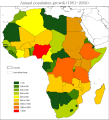
The annual population growth is derived by FAOSTAT dataset, from 1961 to present, and up to 2050 for the projected population. This dataset has been produced in the framework of the "Climate change predictions in Sub-Saharan Africa: impacts and adaptations (ClimAfrica)" project, Work Package 4, Deliverable 4.1 (WP4-D4.1). More information on ClimAfrica project is provided in the Supplemental Information section of this metadata.
-
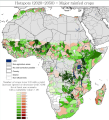
The hotspots zones of all the rainfed crops have been combined with the suitability classes as follow. The number of crops with a yield increase or decrease of more than 10 and 20% has been computed considering two suitability thresholds: one above 0% and another one above 40%. The results have been mapped showing the areas with positive impact in green and the areas with a negative impact in red. One map has been produced considering at least one scenario showing the same trend and the other one considering at least two scenarios showing the same trend. This data set has been produced in the framework of the “Climate change predictions in Sub-Saharan Africa: impacts and adaptations (ClimAfrica)” project, Work Package 4 (WP4). More information on ClimAfrica project is provided in the Supplemental Information section of this metadata.
-
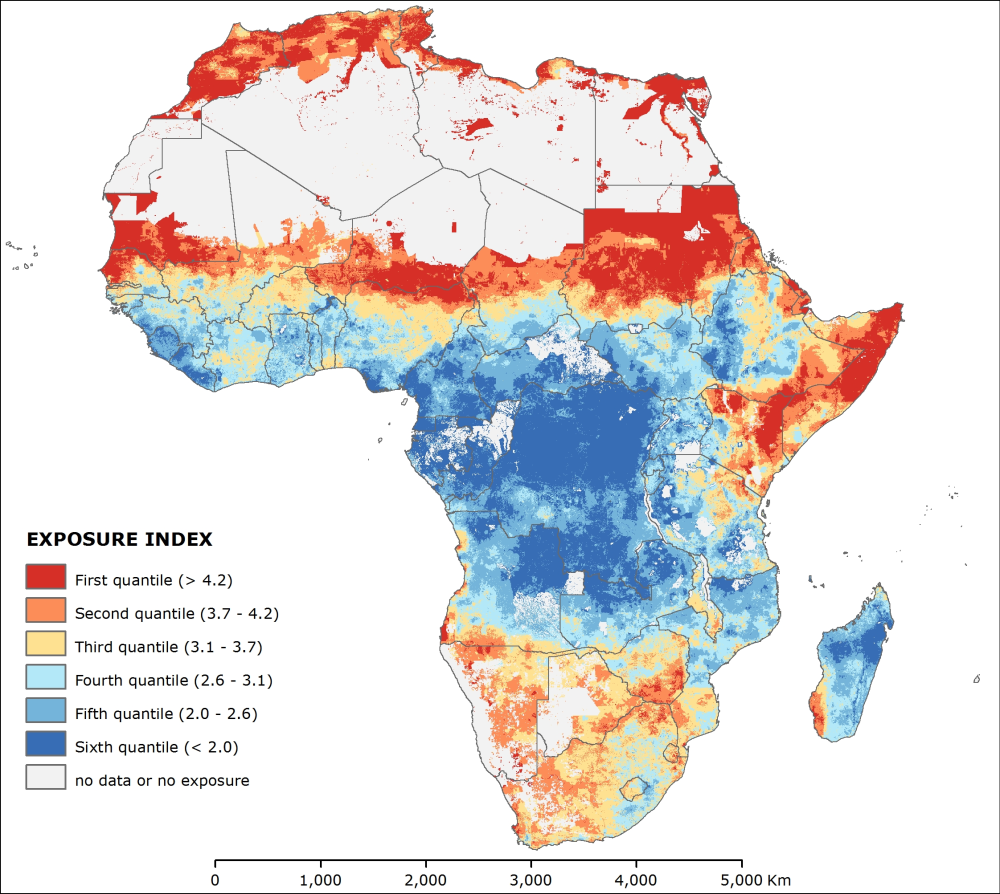
The “exposure index” relates to exposure that is the degree of climatic stress upon a particular unit of analysis or element at risk in 2010. The exposure is commonly defined like the combination between the density of element at risk and a hazard. Here the elements at risk are people, livestock units and crop land and the hazard is the climate change and its impacts. Thus the index results from the addition of two underlying indexes: the “element at risk index” and the “climatic stress index”. The relative weights of underlying indexes were 0.28 and 0.72 respectively for the “element at risk” and the “climatic stress indexes”. These weights were defined through Principal Component Analysis (retaining three components) among ten variables which compose the two underlying indexes. This dataset has been produced in the framework of the “Climate change predictions in Sub-Saharan Africa: impacts and adaptations (ClimAfrica)” project, Work Package 4 (WP4). More information on ClimAfrica project is provided in the Supplemental Information section of this metadata.
-
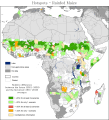
Hotspots zones have been identified for each agro-climatic and climatic parameter and future period, based on the yield anomaly classes (relative differences between the future and the historical period). For each crop and each period, the hotspots are represented by 5 classes: - Zones with a high decrease (>20%) for at least one scenario - Zones with a high decrease (>20%) for at least two scenarios - Zones with a high increase (>20%) for at least one scenario - Zones with a high increase (>20%) for at least two scenarios - Zones with a contradictory information between models This data set has been produced in the framework of the “Climate change predictions in Sub-Saharan Africa: impacts and adaptations (ClimAfrica)” project, Work Package 4 (WP4). More information on ClimAfrica project is provided in the Supplemental Information section of this metadata..
-
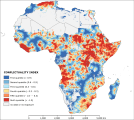
The “conflictuality index” describes the impact that conflicts have in a certain area in 2010. Area subjected to violence and conflict may have problem to receive assistance to develop adaptation measures and may lack the wiliness of the authority to implement such adaptation. The index results from the second cluster of the Principal Component Analysis preformed among 18 potential variables. The analysis identifies two dominant variables, namely “distance from conflict events” and “conflict events density”, assigning equal weights (0.5) to the two variables. Before to perform the analysis the variables were log transformed to shorten the extreme variation and then were score-standardized (converted to distribution with average of 0 and standard deviation of 1; inverse method was applied for “conflicts events density”) in order to be comparable. A shapefile of conflict events was gathered from the Uppsala Conflict Data Programme (UCDP). Considering that the effect of conflict aftermath may during years, we collect all the events position and number of victims from 1989 to 2010. The “distance from conflicts” was obtained via Euclidean distance calculation of the conflict events. The “conflict events density” is the result of a kernel density analysis on number of victims with a search radius of 200 Kilometer. This dataset has been produced in the framework of the “Climate change predictions in Sub-Saharan Africa: impacts and adaptations (ClimAfrica)” project, Work Package 4 (WP4). More information on ClimAfrica project is provided in the Supplemental Information section of this metadata.
-
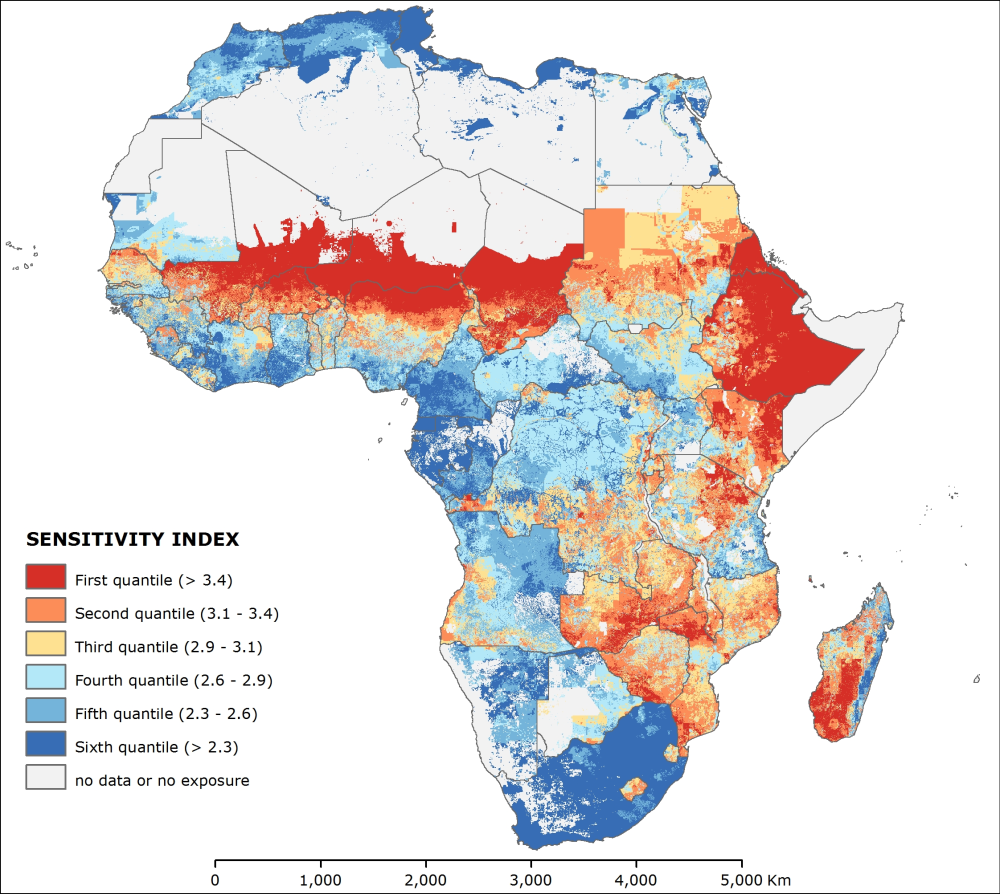
The “sensitivity index” describes the sensitivity or the human–environmental conditions that can worsen the hazard, ameliorate the hazard, or trigger an impact in 2010. Sensitivity in its general sense is defined as the degree to which a system is modified or affected by an internal or external disturbance or set of disturbances. This measure, which herein reflects the responsiveness of a system to climatic influences, is shaped by both socio-economic and ecological conditions and determines the degree to which a group will be affected by environmental stress. Therefore, the “sensitivity index” results from the addition of underlying indexes, namely the “human sensitivity index” and the “natural sensitivity index”, which relative weights are 0.55 and 0.44, respectively. The weights were computed via Principal Component Analysis among the primary variables that compose the two underlying indexes. This dataset has been produced in the framework of the “Climate change predictions in Sub-Saharan Africa: impacts and adaptations (ClimAfrica)” project, Work Package 4 (WP4). More information on ClimAfrica project is provided in the Supplemental Information section of this metadata.
-
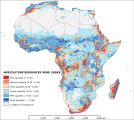
The “agriculture resources sensitivity” represents the agriculture potential in 2010. This potential is measured by the availability of land and food production per capita, and the main thread to agriculture land, represented by desertification risk. The index results from the second cluster of the Principal Component Analysis preformed among 16 potential variables. The analysis identify four dominant variables, namely “potential rain-fed food production per capita”, “cropland crowding”, “desertification index” and “topographic resources availability”, assigning respectively the weights of 0.29, 0.29, 0.27 and 0.15. Before to perform the analysis all the variables were log transformed to shorten the extreme variation and then were score-standardized (converted to distribution with average of 0 and standard deviation of 1; all variables with inverse method except “desertification index”) in order to be comparable. The 5 arc-minute grid “potential rain-fed food production per capita” of 2007 was gathered from FAO GeoNetwork and then sampled at 0.5 arc-minutes. It was multiplied by crop land occurrence dataset, extracted from the FAO Global Land Cover-SHARE dataset of 2014 and divided by population grid in order to compute the per capita values. The 0.5 arc-minute grid “cropland crowding” of 2010 was produced dividing the crop land occurrence (FAO Global Land Cover-SHARE) by the population. The 0.5 arc-minute grid “desertification index” of 2000 was measured in terms of number of months recording values less than 0.75 of the ratio between precipitation (current monthly average) and potential evapo-transpiration (PET, current monthly average). Data of precipitation and PET were gathered from Worldclim and from CGIAR Consortium for Spatial Information, respectively. Finally the 0.5 arc-minute grid “topographic resources availability” was produced within the ClimAfrica project based on SRTM DEM of NASA. The “potential rain-fed food production per capita” measures the availability of food in a certain area produced with subsistence techniques. Cells with low food production are sensitive to climate change impacts because the low input agriculture (dominant in Africa) may not produced sufficient food quantities to support the local populations. The “cropland crowding” is an indicator that assess the availability of crop land hectares per 1,000 people. Sensitive areas are where few crop lands are shared by large population. The “desertification index” assesses the climatological risk of a certain area to be subjected to desertification due to lack of rainfall. Such areas are more sensitive to lost crop land and thus food production quantities due to climate change impacts. The “topographic resources availability” is the percentage of each cell with slopes equal to or lower than 15 %. Landscapes strongly dissected contain less land with agriculture values than plain landscapes. The scarcity of agriculture land may increase the fragility of a system because unable to increase to crop surface to cope with climate change impacts. This dataset has been produced in the framework of the “Climate change predictions in Sub-Saharan Africa: impacts and adaptations (ClimAfrica)” project, Work Package 4 (WP4). More information on ClimAfrica project is provided in the Supplemental Information section of this metadata.
-
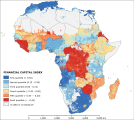
The “financial capital index” represents the economic means that determine the potential adaptive capacity degree of a particular unit of analysis in 2010. It is linked with the richness and the attained degree of economical development of a certain population. It is the combination of two underlying indexes: the “financial development index” and the “richness index”. These original indexes correspond to the two principal components identified by Principal Component Analysis among 9 potential variables. The analysis assigned relative weights to the “financial development index” and the “richness index”, that are 0.51 and 0.49, respectively. This dataset has been produced in the framework of the “Climate change predictions in Sub-Saharan Africa: impacts and adaptations (ClimAfrica)” project, Work Package 4 (WP4). More information on ClimAfrica project is provided in the Supplemental Information section of this metadata. This dataset has been produced in the framework of the “Climate change predictions in Sub-Saharan Africa: impacts and adaptations (ClimAfrica)” project, Work Package 4 (WP4). More information on ClimAfrica project is provided in the Supplemental Information section of this metadata.
-

The “richness index” represents the level of economical wellbeing a country certain area in 2010. Regions with higher income per capita and low poverty rate and more access to market are wealthier and are therefore better able to prepare for and respond to adversity. The index results from the second cluster of the Principal Component Analysis preformed among 9 potential variables. The analysis identifies four dominant variables, namely “GDPppp per capita”, “agriculture share GDP per agriculture sector worker”, “poverty rate” and “market accessibility”, assigning weights of 0.33, 0.26, 0.25 and 0.16, respectively. Before to perform the analysis all variables were log transformed (except the “agriculture share GDP per agriculture sector worker”) to shorten the extreme variation and then were score-standardized (converted to distribution with average of 0 and standard deviation of 1; inverse method was applied for the “poverty rate” and “market accessibility”) in order to be comparable. The 0.5 arc-minute grid total GDPppp is based on the night time light satellite imagery of NOAA (see Ghosh, T., Powell, R., Elvidge, C. D., Baugh, K. E., Sutton, P. C., & Anderson, S. (2010).Shedding light on the global distribution of economic activity. The Open Geography Journal (3), 148-161) and adjusted to national total as recorded by International Monetary Fund for 2010. The “GDPppp per capita” was calculated dividing the total GDPppp by the population in each pixel. Further, a focal statistic ran to determine mean values within 10 km. This had a smoothing effect and represents some of the extended influence of intense economic activity for the local people. Country based data for “agriculture share GDP per agriculture sector worker” were calculated from GDPppp (data from International Monetary Fund) fraction from agriculture activity (measured by World Bank) divided by the number of worker in the agriculture sector (data from World Bank). The tabular data represents the average of the period 2008-2012 and were linked by country unit to the national boundaries shapefile (FAO/GAUL) and then converted into raster format (resolution 0.5 arc-minute). The first administrative level data for the “poverty rate” were estimated by NOAA for 2003 using nighttime lights satellite imagery. Tabular data were linked by first administrative unit to the first administrative boundaries shapefile (FAO/GAUL) and then converted into raster format (resolution 0.5 arc-minute). The 0.5 arc-minute grid “market accessibility” measures the travel distance in minutes to large cities (with population greater than 50,000 people). This dataset was developed by the European Commission and the World Bank to represent access to markets, schools, hospitals, etc.. The dataset capture the connectivity and the concentration of economic activity (in 2000). Markets may be important for a variety of reasons, including their abilities to spread risk and increase incomes. Markets are a means of linking people both spatially and over time. That is, they allow shocks (and risks) to be spread over wider areas. In particular, markets should make households less vulnerable to (localized) covariate shocks. This dataset has been produced in the framework of the “Climate change predictions in Sub-Saharan Africa: impacts and adaptations (ClimAfrica)” project, Work Package 4 (WP4). More information on ClimAfrica project is provided in the Supplemental Information section of this metadata.
 FAO Map Catalog
FAO Map Catalog